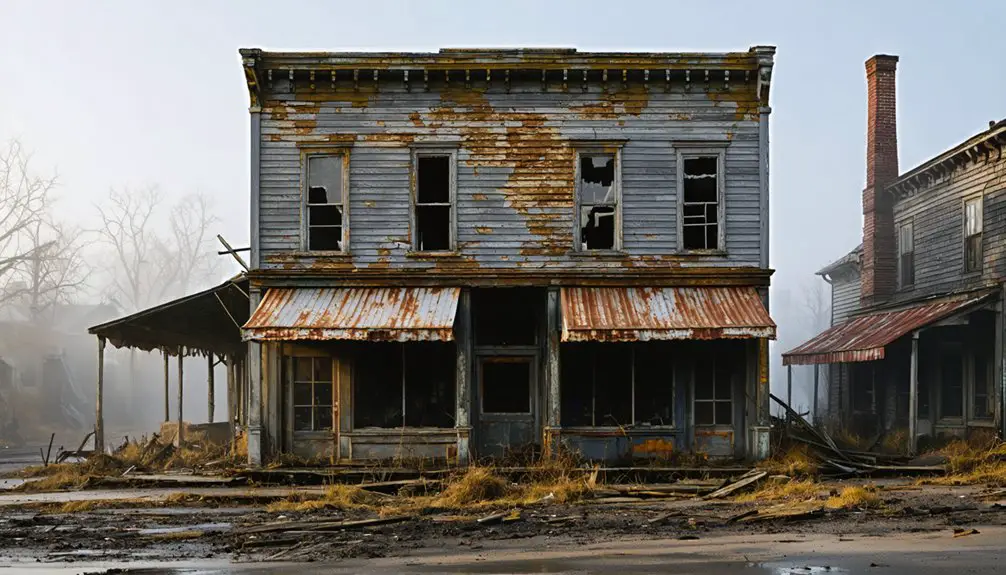You’ll find Weston, Washington nestled in the Cascade Mountains where it served as an essential helper station for Northern Pacific Railway along Stampede Pass. Established in 1900, the town supported steam engines maneuvering a challenging 2.2% grade near the confluence of Green River and Friday Creek. While its infrastructure included an engine house, telegraph station, and innovative loop track, Weston’s fate was sealed when diesel locomotives made helper stations obsolete in 1944. The town’s remaining structures tell a fascinating story of railway innovation and decline.
Key Takeaways
- Weston was established around 1900 by Northern Pacific Railway as a helper station along Stampede Pass in Washington state.
- The town’s infrastructure centered on railway operations, featuring an engine house, telegraph station, water tank, and innovative loop track.
- Geographic constraints between the Cascade Range and Green River limited expansion possibilities, contributing to the town’s eventual abandonment.
- The switch to diesel locomotives in 1944 made Weston’s railway support functions obsolete, leading to its decline.
- Historic railway structures, including a trestle, remain visible today as evidence of Weston’s past as a vital transportation hub.
The Birth of a Railway Helper Station
Railway ingenuity birthed Weston around 1900 as Northern Pacific Railway‘s western helper station along Stampede Pass.
Northern Pacific Railway’s strategic vision established Weston in 1900, creating a vital helper station to conquer Stampede Pass’s challenges.
You’ll find it was purposefully positioned near the confluence of Green River and Friday Creek, creating a crucial push point for steam engines tackling the challenging 2.2% grade to Stampede Tunnel’s summit.
The station’s helper engine operations required specialized infrastructure, including an engine house, telegraph station, water tank, and turntable. Like many locations sharing the name Weston in Wisconsin, this railway stop became a vital transportation hub. Similar to the Southern Railway acquisition in 1894, the station saw increased traffic during wartime operations.
As freight traffic increased, Weston proved essential for safe transit through the Cascades.
Working in tandem with its eastern counterpart at Easton, the station managed railway traffic management through a unique loop track configuration known as the Weston Loop.
This innovative design replaced traditional linear helper tracks, maximizing efficiency in the geographically constrained location.
Strategic Location and Infrastructure
Geography dictated Weston’s strategic position between the imposing Cascade Range to the north and the Green River to the south.
You’ll find it nestled at the foot of Northern Pacific Railway’s challenging western 2.2% grade leading to Stampede Tunnel, where geographic isolation shaped its destiny as a crucial helper station.
The town’s infrastructure centered on essential railway operations, featuring an engine house, telegraph station, water tank, and turntable. Like Franklin’s early development, the area relied heavily on local aggregate materials for constructing foundations and other infrastructure.
A distinctive Weston Loop and cut-off line managed rail traffic efficiently, while twin crossings of the Green River optimized the route.
Despite its strategic importance, logistical constraints from the surrounding terrain limited expansion possibilities, much like many abandoned rail towns across Washington state.
The modest telegraph station, measuring roughly 20 by 30 feet, symbolized the town’s focused purpose: serving the railway’s operational needs.
Northern Pacific Railway Operations
Operations at Weston marked a significant chapter in Northern Pacific’s westward expansion, beginning with the company’s 1871 entry into Washington Territory.
You’ll find that labor dynamics in the region shifted dramatically as the railway became one of the largest labor brokers in the area, heavily relying on Chinese workers for challenging construction projects.
The company’s ambitious plans were fueled by extensive land grants totaling nearly 40 million acres along rail corridors.
While financial troubles, including Jay Cooke’s bank collapse in 1873, temporarily halted progress, the railway’s influence remained substantial. Construction would later resume in 1876 near Puyallup.
Captain John Ainsworth advised on critical land selections for the railroad’s construction, helping shape its strategic route through the territory.
Through strategic partnerships and infrastructure development, Northern Pacific established crucial connections between Minnesota and the Pacific Northwest, transforming isolated territories into interconnected economic hubs and shaping the region’s development patterns for decades to come.
Rise and Fall Along Stampede Pass
While the Northern Pacific Railway expanded westward through Washington Territory, the town of Weston emerged around 1900 as a critical helper station at Stampede Pass‘s western base.
You’ll find this fascinating piece of railway history centered around Weston’s strategic position, where engine houses, telegraph stations, and worker facilities supported trains climbing the steep 2.2% grade.
The challenging terrain that led to Virgil Bogue’s discovery of the pass in 1881 made helper stations essential for railway operations.
The 1.86-mile Stampede Tunnel provided a vital rail connection between Spokane and Seattle when it opened in 1888.
Weston’s economic decline began in 1891 when the Northern Pacific moved its helper terminus to Lester, four miles west.
The town’s fate was sealed by geographic constraints – boxed in between the Cascade Range and Green River – which prevented expansion.
Engineering Marvels and Challenges
Through remarkable engineering ingenuity, Weston’s railroad infrastructure tackled the challenging 2.2% grade at Stampede Pass’s western approach.
You’ll find the Northern Pacific’s innovative solution in their unique loop design, which crossed the Green River twice to help trains manage the steep climb more effectively.
Much like the unimproved dirt road encountered near Goodnow, geographic constraints played a significant role in shaping engineering innovations at Weston.
Hemmed in by the Cascade Range and Green River, engineers had to maximize limited space with helper stations, water tanks, and a turntable.
By 1915, they’d replaced the original loop with a steel trestle and double tracking to improve efficiency.
When Northern Pacific switched to diesel locomotives in 1944, the need for these complex engineering solutions diminished significantly.
While these developments showcased impressive problem-solving, the site’s confined location ultimately led to Weston’s decline, as operations shifted to more spacious facilities in nearby Lester.
Life in a Railway Support Town
Beyond the engineering feats that shaped Weston’s infrastructure, daily life in this railway support town centered on the demanding rhythm of helping trains conquer Stampede Pass.
You’d find railway community dynamics revolving around the engine house, water tank, and telegraph station, where engineers, conductors, and maintenance crews worked tirelessly to assist trains up the steep 2.2% grade.
Worker living conditions were modest but purposeful. You’d have lived in simple housing near the rail facilities, sharing meals at local eating houses that doubled as community gathering spots.
Life moved to the pulse of train schedules, with every resident playing a crucial role in the helper station’s operations. The town’s isolation and limited expansion space meant you’d experience a transient lifestyle deeply intertwined with railroad operations.
Legacy of an Abandoned Settlement

As Northern Pacific Railway modernized its operations around 1915, Weston’s significant role as a helper station quickly faded into obscurity.
Without economic sustainability beyond its railway function, the town couldn’t survive the technological changes that made its loop track and telegraph station obsolete.
You’ll find Weston’s story reflects a common pattern among Washington’s ghost towns, though its singular dependence on railroad operations makes it unique.
Unlike other abandoned settlements that relied on multiple industries, Weston’s community dynamics revolved entirely around supporting train operations.
Today, you can still trace the town’s legacy through remaining railway structures and the historic trestle that replaced its famous loop.
The site serves as a reflection of how rapidly changing transportation technology can reshape community destinies.
Frequently Asked Questions
Are There Any Surviving Photographs of Weston During Its Operational Period?
You’ll find limited photographic archives suggest few surviving operational-period photos exist, though historic preservation efforts hint some images may remain undiscovered in private collections or railway company records.
What Was the Average Number of Residents Living in Weston?
Based on historical demographics, you’re looking at roughly 20-50 residents during Weston’s peak period, with population decline occurring after 1891 when railway operations shifted to Lester, eventually dwindling to zero.
Did Any Notable Accidents or Disasters Occur at the Weston Station?
You’ll find Weston’s darkest railway history occurred on March 1, 1910, when America’s deadliest avalanche struck two Great Northern trains, killing 96 people and leading to the town’s eventual abandonment.
Can Visitors Legally Access the Weston Ghost Town Site Today?
Purposely prohibited private property prevents your access to this ghost town. You’ll need explicit landowner permission to visit legally, as regulations restrict unauthorized entry and visitor guidelines mandate staying away.
Were There Any Schools or Churches Established in Weston?
You won’t find evidence of schools or churches in Weston’s history. The town’s brief existence and focus on railway operations didn’t support these typical community gatherings or permanent institutional buildings.
References
- https://en.wikipedia.org/wiki/Weston
- https://stateofwatourism.com/ghost-towns-of-washington-state/
- https://www.whatcomtalk.com/2020/06/05/the-ghost-towns-of-whatcom-forgotten-but-not-gone/
- https://washingtonourhome.com/ghosts-of-liberty-come-to-life/
- https://www.wta.org/go-outside/seasonal-hikes/fall-destinations/hidden-history-ghost-town-hikes
- https://en.wikipedia.org/wiki/Washington_and_Old_Dominion_Railroad
- https://www.historylink.org/File/20841
- https://railroads.dot.gov/sites/fra.dot.gov/files/2024-03/WUS PA FINAL_Attachment 6_508 pdfa.pdf
- https://www.american-rails.com/maryland.html
- https://www.youtube.com/watch?v=0JLTapdmaYY



